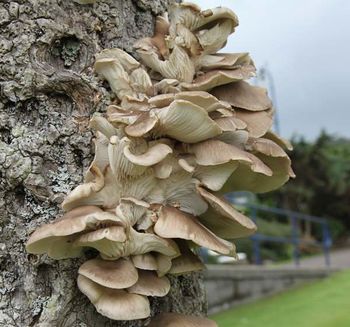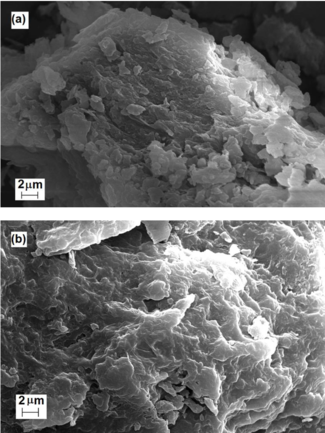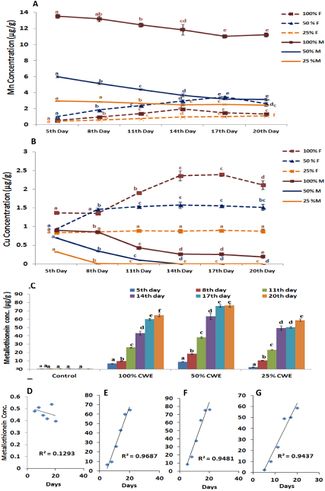Pleurotus ostreatus: Difference between revisions
| Line 27: | Line 27: | ||
[[File:Pleurotus ostreatus_uptake_conc.jpg|thumb|325px|left|Concentration of heavy metal ions in growing fungal mycellia as a factor of differing percent compositions of coal efflux (Huma Vaseema, V. K. Singhbm, M. P.Singh, 2017.) [https://doi.org/10.1016/j.ecoenv.2017.07.001]]] | [[File:Pleurotus ostreatus_uptake_conc.jpg|thumb|325px|left|Concentration of heavy metal ions in growing fungal mycellia as a factor of differing percent compositions of coal efflux (Huma Vaseema, V. K. Singhbm, M. P.Singh, 2017.) [https://doi.org/10.1016/j.ecoenv.2017.07.001]]] | ||
The ion exchange gradient only composes half of the process of biosorpton though. The second step of two centralizes around the mechanisms that concentrate and bind heavy metals to the growing mycelial tissues. Conventionally, the process of chemical precipitation or coagulation has involved the use of lime and aluminum salts to acidify and precipitate out heavy metals at the limitation of being a highly time consuming process (DOI 10.1186/s40201-015-0233-8). In recent years, organic polymers have also been used to bind to and absorb heavy metals, but came with the drawback of producing secondary pollutants form this series of chemical interactions (https://doi.org/10.1016/j.jhazmat.2004.04.018). Similar to the more recent use of organic coagulants in the process of chemical precipitation, the mycelial tissue of the growing microorganism acts as a <br> | The ion exchange gradient only composes half of the process of biosorpton though. The second step of two centralizes around the mechanisms that concentrate and bind heavy metals to the growing mycelial tissues. Conventionally, the process of chemical precipitation or coagulation has involved the use of lime and aluminum salts to acidify and precipitate out heavy metals at the limitation of being a highly time consuming process (DOI 10.1186/s40201-015-0233-8). In recent years, organic polymers have also been used to bind to and absorb heavy metals, but came with the drawback of producing secondary pollutants form this series of chemical interactions (https://doi.org/10.1016/j.jhazmat.2004.04.018). Similar to the more recent use of organic coagulants in the process of chemical precipitation, the mycelial tissue of the growing microorganism acts as a | ||
<br> | |||
Revision as of 16:43, 17 April 2020
Overview

Written by Chris Goodall, Kenyon 22'
Since the commencement of the Anthropocene, humans have continued to produce increasingly significant amounts of conventionally deemed waste products. Ranging from carcinogens to to complex hydrocarbons, the recent accumulation of these synthetic and organic compounds throughout global ecosystems continuously compounds into an ever increasing environmental concern (cite COP 25). Recently, efforts to combat this problematic trend have brought rise to the field of mycoremediation, a subfield of bioremediation. Mycoremediation works around the concept of potentializing non discriminate fungal enzymes as a means of concentrating, removing, and recycling complex pollutants. Among a small handful of other fungal species, Pleurotus ostreatus, a saprotroph commonly known as an Oyster Mushroom, serves a fundamental role in both the development and implementation of this field. Ironically first cultivated as a wartime ration, scientists are now looking now to this achaea for it’s potential in regard to heavy metal and organic bioremediation.
the processes of Mycoremediation practiced by Pleurotus ostreatus can occur through the following three avenues: Biodegradation, Biosorption, and Bioconversion (cite https://www.ncbi.nlm.nih.gov/pmc/articles/PMC4052754/). Biodegradation focuses around the process of disassembling complex nutrients into more elementary mineral components (CO2, NO3, H2O). In addition to removing organic pollutants, the fruiting body of the fungi produced during this process can also serve as a source of ~people food~. Biosorpton centralizes less around catabolic activity and rather involves absorptive interactions with heavy metal ions. Because this process focuses around concentration rather than degradation, the fruiting bodies produced through this process are both toxic and inedible. Lastly, Bioconversion pertains to the recycling of agro-industrial sludges, an umbrella term for compounded organic waste. this serves as a useful alternative to recirculating said sludge as fertilizer in agricultural systems.
In the following, I hope to properly highlight the significant and vastly untapped potential of Pleurotus ostreatus.
Section 1 -- Cellular Structure
niche formation, historical uses, all that good stuff
Include some current research, with at least one figure showing data.
Every point of information REQUIRES CITATION using the citation tool shown above.
Section 2 -- Pleurotus ostreatus: the next heavy metal champion

Looking to Pleurotus osteratus' potential to enact heavy metal bioremediation it's proper to first expand upon the importance of and mechanisms behind the previously outlined concept of biosorption. Heavy metal contaminates laden throughout industrial wastewater systems pose as an environmental concern due to their inability to biodegrade and compounded toxicity under concentration. Failure to properly handle these effluents allow for them to accumulate through the organisms composing adjacent ecosystems inevitably posing a significant health risk to the well being of the food chain (https://doi.org/10.1016/S0956-053X(97)10006-X). Some of the more prevalent metals found in these industrial effluents include lead, cadmium, cobalt, iron, zinc, nickel, and copper (https://www.sciencedirect.com/science/article/abs/pii/S0147651317304141?via%3Dihub). All of which have the potential to form free radicals and cause detrimental confirmation changes in enzymatic function due to the oxidized states in which they are dispatched into these effluents (https://www-sciencedirect-com.libproxy.kenyon.edu/science/article/pii/S0304389409000806?via%3Dihub).
Prior to the more recent and widespread use of mycelium biosorption, ulterior methods have included ion exchange, chemical precipitation, coagulation, and membrane filters (doi:10.1016/j.memsci.2009.03.030). Although effective to a certain extent, historically, each one of these processes ends up producing various secondary toxic sludges. Specifically looking to ion exchange, as it pertains to a similar uptake method practiced by Pleurotus ostreatus, the synthetic process produces a significant amount of hydroxide sludge that almost counteracts efforts to detoxify the effluent produced (http://researchrepository.murdoch.edu.au/). Instead of releasing heavy metals into waterways, industrial companies have opted for alkali sludge. Fortunately, the first step of biosorption practiced by Pleurotus osteratus poses a cheaper and more effect solution to this back ended problem. As suggested by Tay et al. 2011, Pleurotus ostreatus uses a coupled mechanism of chemisorption (link wikipedia or something) with a potassium ion gradient to draw heavy metal ions into its mycelial tissues(https://doi.org/10.1007/s11814-010-0435-9). Additionally, this preposed mechanism has been observed in subsiquent publications through interactions with chromium, copper, and lead (https://doi.org/10.1016/j.mineng.2007.08.013). The rate of uptake for these nutrients produce sigmoidal curves indicate of second order kinetics with distinguishable lag, log, and stationary phases. Furthermore the maximum biosorption capacity per mg mycelial tissues far out-succeeds the potential of synthetic ion-exchange practices and also does so without generating the byproduct of an alkali sludge (https://doi.org/10.1007/s11814-010-0435-9. Additionally, From an economic standpoint, Pleurotus ostreatus mediated biosorption is vastly less expensive than its synthetic counterparts under low concentrations of metals in efflux (https://doi.org/10.1016/j.procbio.2004.12.007). As a follow up, the biosorption potential of Pleurotus ostreatus is connected to the concentration of heavy metal ions originally present in the efflux. More specifically, diluted efflux concentrations showed the greatest potential for biosorption (https://doi.org/10.1016/j.ecoenv.2017.07.001). Interestingly, the process of biosorption also doesn't necessarily rely on the Pleurotus species to be alive. According to Srinath et al. 2002, because the process of biosorbtion is metabolism independent, both living and dead cells have the potential to enact it (10.1016/S0045-6535(02)00089-9). As a result, efflux priorly too hazardous even for the survival of these versatile archaea can still undergo the process of biosorption with the implementation of inanimate Pleurotus osreatus.

The ion exchange gradient only composes half of the process of biosorpton though. The second step of two centralizes around the mechanisms that concentrate and bind heavy metals to the growing mycelial tissues. Conventionally, the process of chemical precipitation or coagulation has involved the use of lime and aluminum salts to acidify and precipitate out heavy metals at the limitation of being a highly time consuming process (DOI 10.1186/s40201-015-0233-8). In recent years, organic polymers have also been used to bind to and absorb heavy metals, but came with the drawback of producing secondary pollutants form this series of chemical interactions (https://doi.org/10.1016/j.jhazmat.2004.04.018). Similar to the more recent use of organic coagulants in the process of chemical precipitation, the mycelial tissue of the growing microorganism acts as a
--outline the process of the metals binding to the mushroom throughly. talk about how this process continues to intertwine the two steps on the basis of cost and unison of two preexisting treatments in a more effective manner. mentaion again how the mushroom can even be a dead sponge if that's what you're really into. then talk about how these metals can then be harvested/purified back from the mushroom and re-used in the continuation of their industrial efforts. it's a win for both the company from a cost perspective, makes them look good from an environmental perspective, and overall improves the quality of the water surrounding the plant. as previously mentioned, this then detoxifies the surrounding ecosystems and prevents the inevitable accumulation of heavy metals into the foods that we consume. yeay! we can eat more swordfish because we mess them up enough already. (will be back after lunch)
Previously overlooked for many years, biosorption has gained traction in recent years on account of its ability to outcompete industrial remediation counterparts from both an economic and environmental standpoint (https://kopernio.com/viewer?doi=10.1007%2Fs11814-010-0435-9&token=WzQ5MTg3MiwiMTAuMTAwNy9zMTE4MTQtMDEwLTA0MzUtOSJd.8TXO2izwQ4Qg6UcJLFvq6FDHEYE).
The process itself then occurs through two core mechanisms. the first being a metabolically-dependent process pertaining to the uptake of the nutrient itself.
"Heavy metal pollution due to coal washery effluent and its decontamination using a macrofungus, Pleurotus ostreatus".
https://doi.org/10.1016/j.ecoenv.2017.07.001
Additionally, Biosorption does not require Pleurotus ostreatus to necessarily be alive increasingly factoring into its potential use for the management of industrial efflux. (Mar'in A, Conti C, Gobbi G. Sorption of lead and caesium by mushrooms grown in natural conditions. Res Environ Biotechnol. 1997;4:35–49.)
“Ligninolytic fungi, such as Phanerochaete chrysosporium, Bjerkandera adusta, and Pleurotus ostreatus, have the capacity of PAH degradation. The enzymes involved in the degradation of PAHs are ligninolytic and include lignin peroxidase, versatile peroxidase, Mn-peroxidase, and laccase.” https://doi.org/10.1155/2012/243217
"Biosorption of cadmium ions using Pleurotus ostreatus: Growth kinetics, isotherm study and biosorption mechanism"
https://link.springer.com/article/10.1007%2Fs11814-010-0435-9
this focuses around the recycing of cadmium, and the extraction from the fruiting body for further use.
Section 3 -- Pleurotus ostreatus: powered by fossil fuels
“Bioremediation of long-term PCB-contaminated soil by white-rot fungi” doi:10.1016/j.jhazmat.2016.11.044.
- “The best results were obtained with P. ostreatus, which resulted in PCB removals of 18.5, 41.3 and 50.5% from the bulk, top (surface) and rhizosphere, respectively, of dumpsite soils after 12 weeks of treatment”
“Metabolism of phenanthrene by the white rot fungus Pleurotus ostreatus.”
https://www.ncbi.nlm.nih.gov/pubmed/8779594
"Anti-Growth Factors Associated with Pleurotus ostreatus in a Submerged Liquid
Fermentation" https://scholar.google.com/scholar_lookup?journal=Malaysian+J+Microbiol&title=Anti-growth+factors+associated+with+Pleurotus+ostreatus+in+a+submerged+liquid+fermentation&author=JB+Akinyele&author=S+Fakoya&author=CF+Adetuyi&volume=4&publication_year=2012&pages=135-140&
basically this is looking into industrial sludge being recycled into something useful. it's not necessarily toxic by any means, more of just waste product that they couldn't find use for and is quite difficult to get rid of.
"Degradation of oxo-biodegradable plastic by Pleurotus ostreatus."
https://www.ncbi.nlm.nih.gov/pubmed/23967057
less of an organic waste cleanup and more of a recycling effort, this avenue speaks on the ability for these mushrooms to recycle a more eco-friendly source of plastic.
(include some information on organic bioremediation)
Include some current research, with at least one figure showing data.
Section 4 -- The Carcinogen Cleaner
literally resistant to other clean up measures and carcinogenic in cases
nope, our mushroom friends said fuck it, i’ll turn that into a fruiting body
Bioremediation of Direct Blue 14 and Extracellular Ligninolytic Enzyme Production by White Rot Fungi: Pleurotus Spp. doi:10.1155/2013/180156
Conclusion
References
Authored for BIOL 238 Microbiology, taught by Joan Slonczewski, 2018, Kenyon College.
